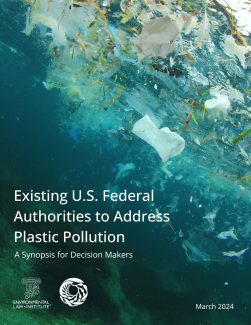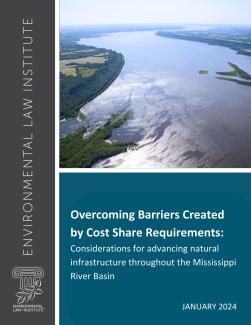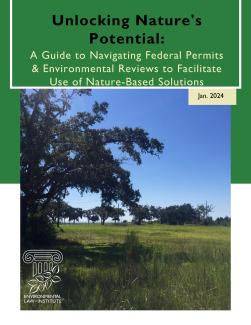Some two billion people — a quarter of humanity — lack access to safe, readily available drinking water. Moreover, freshwater security is increasingly threatened as the result of climate change, unsustainable development, and population growth. In the midst of this burgeoning water crisis, the rights of communities around the world who collectively hold, manage, and depend on freshwater resources continue to be inadequately recognized and protected. Securing the legal basis for indigenous and local community water rights can be a key national and local response.
Indigenous peoples and local communities continue their struggle to gain legal recognition of land, water, and other natural resources found within the territories they have traditionally stewarded. The realization of communities’ freshwater tenure is particularly essential to their ability to maintain food security and livelihoods, as well as to achieve other sustainable development objectives.
Observing the ways in which secure tenure underpins equitable and sustainable development, many countries have made tangible progress in legally recognizing and protecting land and forest rights. But water tenure has received far less attention. Indeed, the definition and understanding of the term itself is still evolving. Additionally, the most fundamental legal entitlements that support communities’ water security have yet to be fully articulated or generally endorsed internationally.
The development of principles and tools to guide policy and legal reforms, notably the UN Voluntary Guidelines on the Responsible Governance of Tenure of Land, Fisheries, and Forests, has provided an important basis for building policy consensus on what constitutes responsible governance of tenure. A key aspect of this international consensus has been the importance of prioritizing the rights of the rural poor. Early discussions on the inclusion of water tenure in such guidance foundered on the unique aspects of water as a fugitive, inherently shared, and essentially public resource, which collectively makes it difficult to conceptualize water tenure in the same way that tenure is framed in the context of land and other terrestrial resources. Nevertheless, it is possible to articulate — both conceptually and based on legislative practice — a core set of water rights that comprise (in varying formulations) the diverse water tenure regimes found around the world. Taking this bundle-of-rights approach enables countries to identify areas for harmonization of legislation across water, land, forest, and other key resource sectors and, in turn, provides an important framework that can support integrated and more equitable governance.
The importance of water tenure, its practical and legal interdependencies with land and forest tenure, and the need for the further development of its conceptualization in policy and practice led to a joint undertaking by the Rights and Resources Initiative and ELI to develop a framework designed to conceptualize, compare, and track national-level legal recognition of the most essential rights for securing community-based freshwater tenure.
We applied this Freshwater Tenure Methodology across 15 countries spread through Africa, Asia, and Latin America in order to assess the extent to which various national-level legal frameworks within these countries recognize and protect the freshwater rights of indigenous peoples and local communities. Importantly, we also focused on the role of women within those communities in water use and governance. The findings from this analysis — titled, “Whose Water? A Comparative Analysis of National Laws and Regulations Recognizing Indigenous Peoples’ and Local Communities’ Water Tenure”— is now available online. The dataset underpinning its findings will be expanded and updated over time.
Drawing on widely accepted understandings of land, forest, and fisheries tenure, the UN Food and Agriculture Organization has proposed this definition of water tenure: “The relationship, whether legally or customarily defined, between people, as individuals or groups, with respect to water resources.” This definition recognizes that water tenure goes beyond water rights to capture diverse legislative and customary systems that shape how various stakeholders — whether as individuals or groups — relate to one another in their use of, and impacts on, this resource. The acknowledgement of customary water tenure regimes is also critical, as they are often the primary means by which many indigenous peoples and local communities determine how group members access, use, and govern the water they need for food, livelihoods, health, and overall well-being.
Water tenure also derives its meaning and utility from the bundle of rights that constitute the fundamental elements of peoples’ relationship with each other when it comes to freshwater resources. Rights to use and manage water are governed both by legislative and customary frameworks, which may or may not be aligned with one another. Unpacking the bundle of rights that constitutes various forms of water tenure thus helps governments and others to understand the diverse ways in which the specific rights constituting tenure regimes are practically formulated, implemented, and enforced.
A bundle-of-rights approach also builds on broadly accepted understandings of common-pool-resource property rights, as well as definitions of land and forest tenure, thus allowing for a comparitive review of regimes at a landscape or territorial level. In many countries, recognition of water rights is predicated on legally recognized land or forest rights. This legislative “land-water nexus” impacts both the realization and security of water tenure rights and points to the need for more coherence across legal frameworks impacting tenure rights in related sectors.
Indigenous and local communities constitute one-third of the world’s rural poor and are among the planet’s most frequently marginalized groups. They face inequities in access to critical services, including education and other essential resources, and suffer from comparatively higher levels of poverty. This enhanced vulnerability is often more pronounced for the women in these communities. As pressures on freshwater resources mount, legal protections for the tenure rights of indigenous peoples and local communities are therefore critical to ensuring their water security.
The legal status of community-based water tenure is often further complicated by the primary role that customary rights can play in determining how some communities use, manage, and govern their water resources. The legal recognition of customary water rights varies widely across countries, and the complex relationships that can arise between legislative and customary water rights may present serious challenges. Given the high level of dependence that local communities in developing countries have on natural resources, securing their water tenure rights is of paramount importance to their ability to support sustainable livelihoods, achieve food security, and enable economic advancement — while also ensuring that communities can continue in their roles as stewards of the freshwater and broader ecosystems on which they, and others in cities and rural areas downstream, depend.
“Whose Water?” follows extensive work by the Rights and Resources Initiative to analyze the extent to which indigenous peoples’ and local communities’ land and forest tenure rights are recognized under national law. Building on RRI’s unique methodological approach, ELI and RRI began developing the Freshwater Tenure Methodology to assess whether community-based freshwater rights, including rights to surface and groundwater, are legally recognized, and how those rights are protected or addressed within national legal frameworks regulating and impacting freshwater resources. We developed the methodology through a highly consultative process and piloted it in three countries before it was finalized.
The methodology defines a community-based water tenure regime as a distinguishable set of national-level, government-issued laws and regulations encompassing situations in which freshwater rights of use and at least either governance or exclusion are held at the community level. Communities are defined broadly to capture a range of indigenous peoples and water-user associations or similar entities that include such communities. Our team identified a total of 39 CWTRs across the 15 countries we assessed: Bolivia, Cambodia, Chile, Colombia, India, Kenya, Liberia, Mali, Mexico, Morocco, Nepal, Panama, Peru, Vietnam, and Zambia.
We then worked with national experts to examine the bundle of rights for each tenure regime using five legal indicators: use, exclusion, transferability, governance, domestic due process, and transboundary due process. In addition, to provide critical context for each regime, the Freshwater Tenure Methodology includes threshold questions to assess legal recognition of the human right to water; customary water rights, laws, traditions, or practices; the dependence of communities’ water rights on their recognized rights to land and forests; and indigenous and rural women’s rights to water.
The right to use water is perhaps the most central right in the bundle, fulfilling basic human needs, ensuring health, and realizing the full suite of human rights that can only be achieved through access to water. To capture the broad range of potential rights that are relevant to communities, our methodology recognizes four categories of commonly recognized uses: for religious or cultural purposes, domestic purposes or basic human needs, small-scale livelihoods, and commercial purposes. Domestic-use rights are the most consistently protected, and the majority of community-based water tenure regimes exempt domestic uses (defined in various ways) from any sort of permitting or licensing requirement.
National laws frequently give these rights legal priority with respect to competing uses. National laws also recognize use rights for livelihoods, although some require a permit or other administrative procedural requirement in order to vest the rights. While permitting systems can help monitor and regulate water use, reduce associated conflicts, enhance sustainability, and generate public revenue, they are seldom adapted to meet the needs and circumstances of local communities. These requirements can translate into a burden for communities in realizing critical use rights for livelihoods where such administrative requirements are coupled with fees, a need to travel sometimes long distances to reach administering agencies, language barriers, and often restricted capacity of government to effectively implement the requirements in remote rural areas.
The rights to plan, make, implement, and enforce decisions and resolve associated disputes — in short, to govern — are also critical aspects of community-based water tenure. To capture the ways in which communities are legally empowered to govern their water resources, the Freshwater Tenure Methodology assesses whether communities have rights to make rules related to their water resources, to make plans and implement those plans by managing those resources, to resolve water-related disputes in the community, and to enforce internal rules related to water. Notably, all but one community-based water tenure regime we identified legally recognize community rights to make rules concerning fresh water, and all 39 recognize communities’ rights to water resource planning and management. However, the tenure regimes that recognize water governance rights are also often premised on the broader legal recognition of communities’ customary or traditional rights to territories or lands and appurtenant resources and are not specific to water. These rights are also found across a range of laws with provisions that may or may not be aligned with the pertinent water legislation.
The right to exclude third parties ensures that communities have the legal authority to protect their water rights and territorial water resources from capture or abuse. Exclusion is generally considered one of the most essential components that make a bundle of terrestrial tenure rights meaningful. However, because of water’s fugitive and shared nature, it can be subject to overlapping claims. Moreover, water rights regimes are often predicated on balancing the public and private property rights in water. This balance is increasingly informed by the legal recognition of water as a human (and constitutional) right, placing a unique onus on governments to ensure equitable access to — and sustainable management of — the resource.
Legal rights to exclude third parties therefore often do not apply to those who seek to use fresh water to fulfill basic human needs, which are generally safeguarded. Exclusion rights also are often limited to private parties, as governments typically establish legal rights to control or even own all fresh water to administer on behalf of citizens as a public trust. However, even given these constraints, over 60 percent of the tenure regimes we analyzed provide some form of exclusion rights to communities. Not surprisingly, most of these are tenure regimes based on a land-water nexus that premises water rights on existing legal rights to land, forest, or territories.
Particularly where exclusion rights are missing or ineffectual, procedural rights enabling access to information, participation in decisionmaking, and access to justice where water rights are infringed upon take on even greater importance. All 39 of the CWTRs recognize communities’ due process rights of prior notice, consultation, and appeal when decisions related to the development or allocation of fresh water (or other related matters) could impact their rights. It is important to note, however, that these rights emanate from multiple sources of law, often outside the water sector, such as land laws and environmental impact assessment provisions. They are therefore not always specific to water resources or the unique impacts they can incur. Some countries have taken the initiative to require free, prior, and informed consent for decisions impacting indigenous and other communities, whether through national legislation or court decisions. Despite these positive developments, the majority of countries provide communities with less robust procedural guarantees to ensure their water rights are not infringed or extinguished by third parties.
Among the most policy relevant findings of our assessment are the variety of ways in which water tenure rights depend upon and are shaped by land and forest rights. The land-water nexus is also directly linked to the diverse ways in which customary land and water laws are given legal status and the legal recognition of indigenous territorial rights.
The nexus takes many forms under diverse national laws, deriving from land, forest, and water laws, as well as national constitutions, local government and administrative laws, and other legislation. In Kenya, for example, land is defined by the constitution to include “any body of water” on or under the surface of the land, and so provides recognition for the water appurtenant to customary lands that are legally recognized under the 2016 Kenyan Community Land Act. In Colombia, Constitutional Court decisions have recognized freshwater rights as integral to communities’ territorial rights, and in Liberia and India, certain communities’ statutory water rights are entirely dependent on their recognized forest rights.
Notably, across our 39 identified CWTRs, those that have a land-water nexus tend to grant stronger overall protections to communities’ water tenure rights. This indicates that water laws are falling somewhat behind in their recognition of CWTRs compared to other sectoral laws. However, it is also important to note that recognition of water-tenure rights is often not explicit when embedded in other sectoral laws or constitutional provisions, but rather included in broader provisions governing rights to territories, lands, or natural resources more broadly.
The recognition of water rights across laws governing lands and forests can provide diverse legal avenues for recognition of water tenure. At the same time, if laws are not consistent in how they address the elements of water tenure, those rights can also be undermined, result in duplicative requirements, or even lead to contradictory provisions. A clear understanding of the specific legal mechanisms creating or shaping the land-water nexus is therefore critical in defining and securing communities’ water tenure. Moreover, the legal interdependencies across water, land, forest, and other resource tenure systems must be reflected in policies and laws that take harmonized approaches to recognizing and protecting land and water rights — or risk undermining tenure security of the most vulnerable.
Our analysis found that only one-third of the tenure regimes legally recognize the specific rights of indigenous and community women to use or govern fresh water. Moreover, two-thirds of those provisions that do recognize women’s water rights are not specific to water, but rather pertain more broadly to rights to natural resources or to community territories, which can be interpreted to include their freshwater resources.
The ability of countries to support women within indigenous and local communities in exercising control over water resources depends largely on the extent to which national laws recognize women’s rights to participate in community-level governance. Without gender-sensitive legal protections, it is difficult to ensure that women can actively engage as equal members in community-level decisionmaking about water to ensure that it is appropriately allocated for their priority domestic and productive needs.
Customary water laws and practices are often the primary means by which indigenous peoples and local communities determine in practice how to access, use, and govern their water. Broadly speaking, customary laws reflect the norms and practices accepted by a community as unifying and obligatory and draw their authority from both contemporary and traditional values, practices, and institutions. They are not static but tend to adapt to community needs and priorities. Where customary rights and laws are not formally recognized, they are at risk of being ignored, manipulated, and eroded when competing claims arise.
Approximately 80 percent of the 39 CWTRs analyzed across Africa, Asia, and Latin America provide legal recognition of customary water tenure rights, creating a legal basis for ensuring the continuity and enforceability of those rights. However, even where customary water tenure rights are recognized, such rights must often be reconciled or harmonized with legislation, which can fundamentally alter their character and functioning. Moreover, even where customary water tenure rights are granted legal recognition, there is a risk that they will not enjoy the same level of enforcement as permitted rights. There is thus a strong need for research to understand the diverse impacts and policy options for improved recognition of customary water tenure rights and more effective harmonization of customary and legislative systems.
Across the water tenure regimes, we found a high number of water rights for livelihoods and commercial uses are subject to permitting or other procedural requirements. These burdens can be significant. In Nepal, for example, communities must form up to three distinct user associations to obtain their full suite of potential water use rights, including those for irrigation. The burden on communities is often compounded by the fact that governments often lack the capacity to implement their own administrative requirements, particularly in rural areas. For example, recent research across five African countries by the International Water Management Institute and the Pegasys Institute demonstrates the inability of countries to achieve even a small fraction of statutory permitting requirements and a bias toward formal, large-scale users.
Our findings highlight a need to more closely tailor water regulatory tools to the needs and priorities of communities, including more effective recognition and protection of customary rights, consideration of alternatives to permitting requirements that balance state policy priorities with the actual capacities of both agencies and communities, and exemption where possible from permitting requirements of critical water rights for domestic and livelihoods uses.
We found that water tenure does exist — in multiple forms — and that it plays a central role in supporting indigenous peoples’ and local communities’ livelihoods, resource governance and protection, and sustainable economic development. The findings also highlight the critical importance of identifying and fully understanding the nuances of the land-water nexus and promoting more integrated, tenure-rights-based approaches to land and water governance. Such approaches must look to incorporate innovative mechanisms for intersectoral coordination and collaboration, as well as better-harmonized legislation. They must also take full account of the differentiated roles, needs, and priorities of men and women through more gender-equitable legal protections for water tenure rights.
A key consideration in determining policy options and legal tools for supporting water rights is the balance that must be struck between security of tenure and the flexibility required to be able to respond to changing availability and quality of water as a result of societal and climate-driven uncertainty and change. This could require, for example, a rethinking of the time limitations provided on administrative water rights, more effective use of legal prioritization of certain uses and water tenure holders under circumstances of scarcity or disaster, and a focus on building the capacity of water tenure institutions for adaptive management that enables adjustments in the face of uncertainty and change while still maintaining equity in allocation and accountability to all tenure holders.
With respect to the water tenure rights of indigenous and local communities, a careful assessment of the resilience of customary water tenure practices and how those can be protected by law could contribute meaningfully to their water security. This could also provide innovative alternatives to alleviate the burden on governments that lack the capacity to meaningfully bring customary tenure holders into the formal administrative water rights system. More broadly, careful consideration of the wide range of potential legal mechanisms for balancing resilience and security must be an integral part of ongoing work on water tenure.
Women within indigenous and local communities have differentiated responsibilities, needs, and priorities with respect to the domestic and productive uses of water and the sustainable management of freshwater resources. Legal recognition of the specific rights of women in these communities to use and govern water is essential for ensuring that they have a meaningful voice in decisionmaking and control over this essential resource. Despite the broad international recognition of women’s critical role in water management and decisionmaking for over 30 years, men continue to dominate water-related governance at all levels, reflecting the persistent, patriarchal gender ideology that prevails in many countries and communities. This status quo is bolstered by the notable absence of gender-sensitive legal protections, as evidenced by the findings described above.
Addressing this status quo will require gender-transformative provisions in water legislation to prohibit discriminatory practices and ensure that women are represented equitably in decisionmaking processes and in institutions charged with water governance. The pervasiveness of the land-water nexus in the legal recognition and protection of water tenure, coupled with the fact that less than 15 percent of landholders globally are women, also indicates gender-equitable water tenure will also require land and forest laws to more adequately protect and respect women’s tenure rights, including their inheritance rights to community lands and resources. To build on those practices and norms that respect resource tenure rights, particularly in the context of community-based tenure, such reforms and the resulting governance institutions must be informed by the voices of the women.
The emergence of environmental rule of law as a priority for international action, as framed by UN Environment and others, provides a critical context shaping how water tenure rights can improve environmental and water governance. While environmental and water laws have proliferated globally in recent decades, equitable and accountable implementation and enforcement of these laws often remain elusive.
The components of environmental rule of law include fair, clear, and implementable legal provisions; meaningful procedural guarantees for public participation; accountable institutions and decisionmaking; clear mandates and institutional roles; accessible, fair, and transparent dispute resolution mechanisms; and recognition of the mutually reinforcing relationship between rights and the rule of law.
These core elements of environmental rule of law must provide the context for the further elaboration of the concept of water tenure and its practical application across various contexts. At the same time, equitable and secure community-based water tenure, as captured in our assessment, has the potential to advance each of these components and contribute to more effective overall water governance at the local and national levels. TEF






